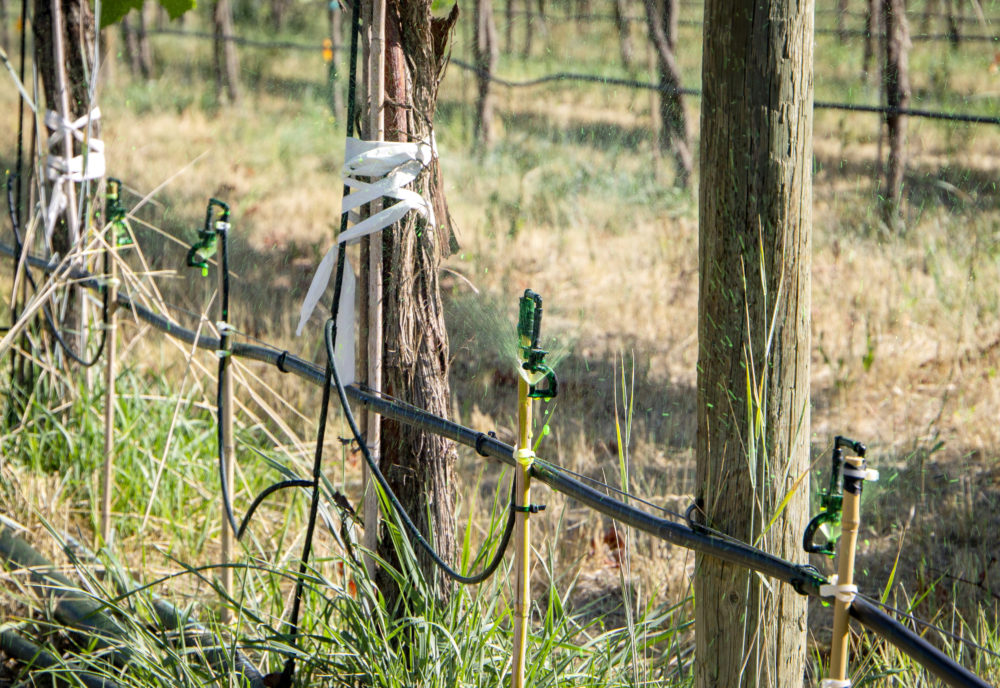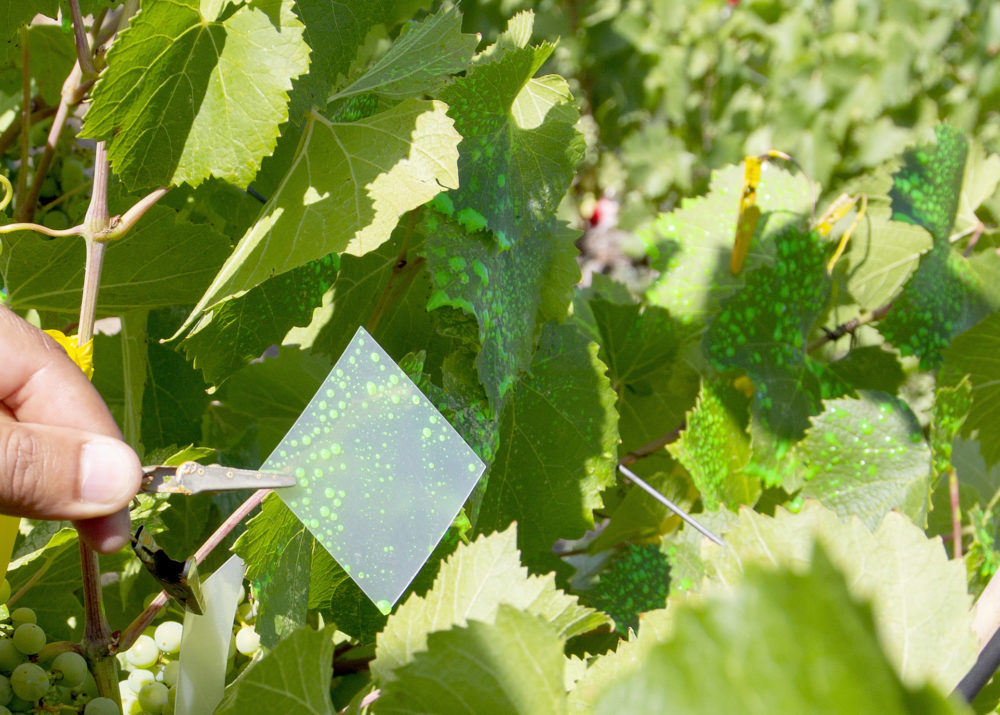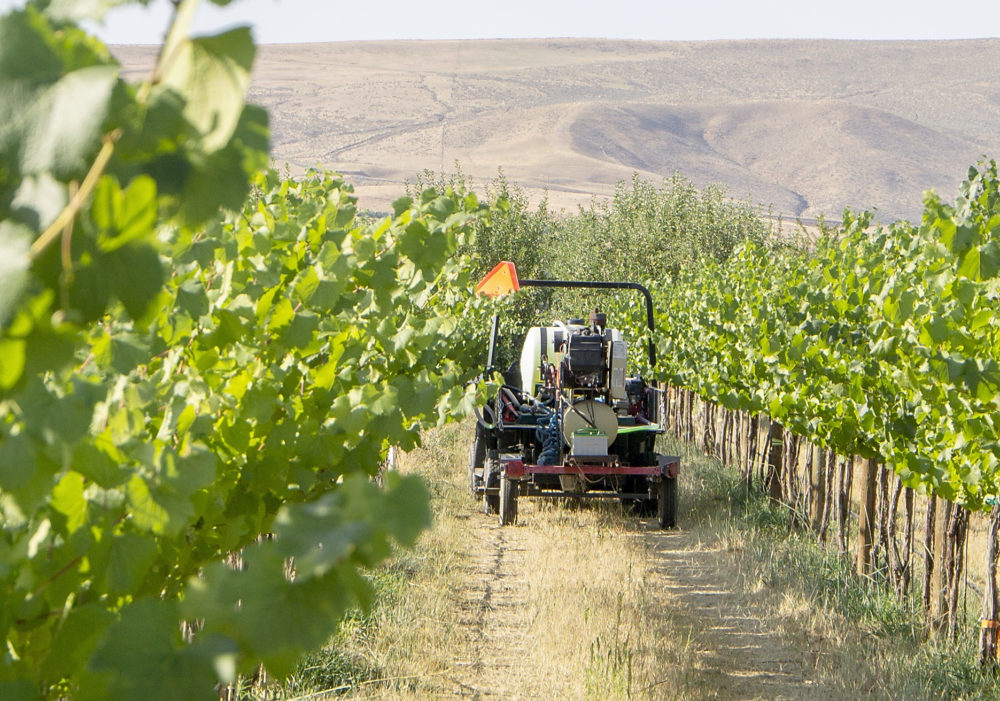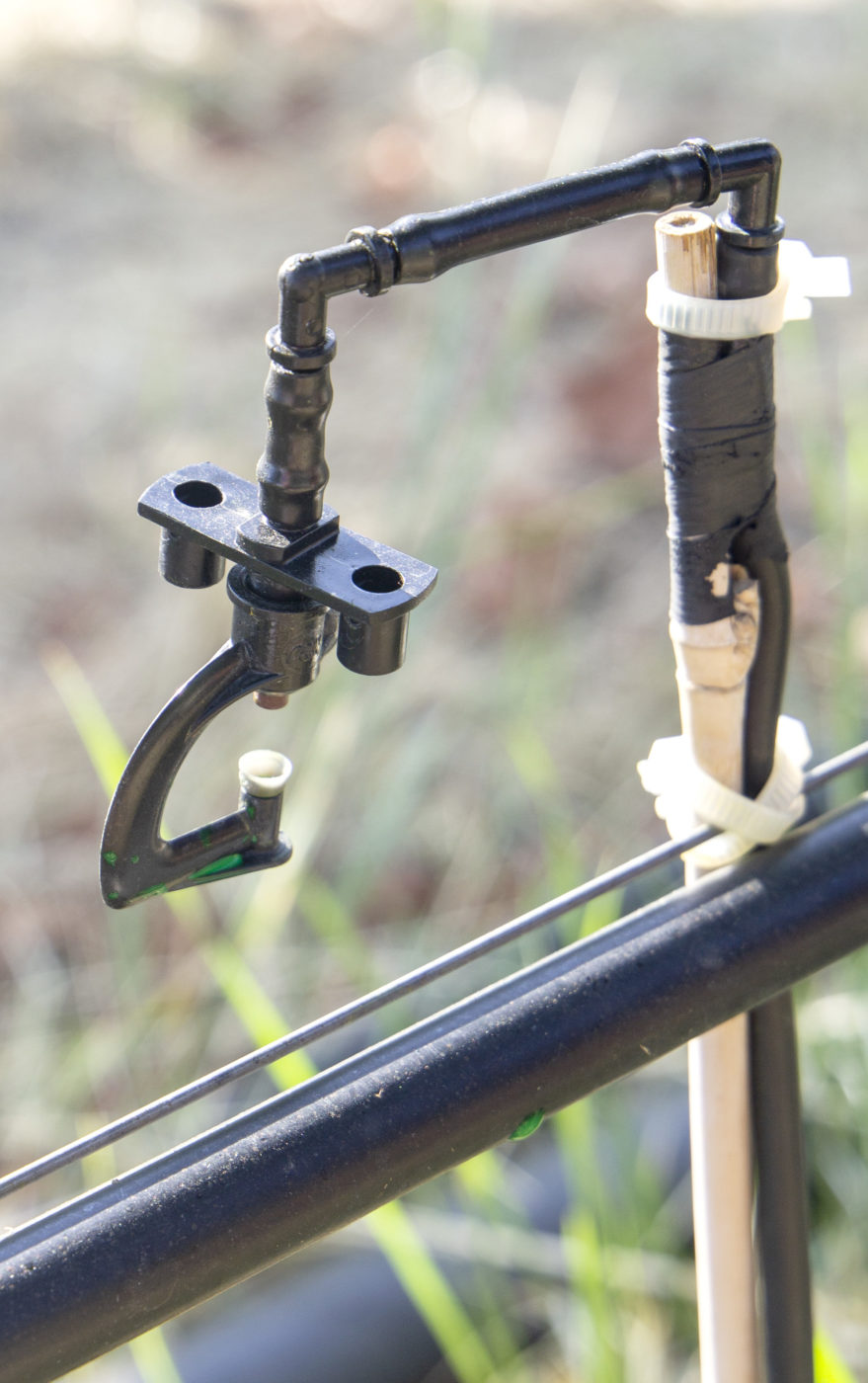
There’s the hum of the compressor, followed by a hiss and a gentle green mist.
Eight seconds later, it’s over.
That’s all it takes to get spray coverage in this vineyard trial, no tractor or sprayer necessary.
That’s the dream of the solid-set spray delivery system: freeing farmers from the tedium of tractor time whilst reducing spray drift and maximizing chemical efficiency. Forced air from a compressor or hydraulic pump pushes spray products from a central tank through a system of delivery lines and emitters designed to meet the specific needs of canopy architecture.
“We are as good as airblast in terms of coverage and deposition, but with less drift,” said Rajeev Sinha, who recently finished his doctorate at Washington State University while working on the system. “The best thing is the part that’s lost to drift in airblast hits the canopy, too.”

Researchers across the country have been collaborating on the idea, which started in tree fruit, for close to a decade now. Matt Grieshop at Michigan State University leads the project, which is funded by U.S. Department of Agriculture Specialty Crop Research Initiative grants.
The second generation of apple systems shows promise in Washington and Michigan experiments, but a more recent trial at WSU’s Irrigated Agriculture Research and Extension Center in Prosser suggests it would work just as well, if not better, in wine grapes.
“The vineyard application, to me, is simpler and there’s more application potential,” said Gwen Hoheisel, a WSU Extension specialist who’s worked with the systems in both vineyards and apple orchards. A grower group has been advising on the project, ensuring that the design fits within existing management, and they are eager to see how well it performs over the next few years of trials, she said.
Wine grapes have the advantage of a smaller canopy, making it easier to get good coverage with fewer nozzles, she said, and the system can be installed pretty easily in an established vertical shoot positioned vineyard. The placement of the delivery lines along the existing drip line and the cordon doesn’t interfere with management practices such as mechanized suckering and shoot thinning.
Engineer Lav Khot leads WSU’s solid-set trials, including the grape project now in its third year, and said his team at the Center for Precision and Automated Agricultural Systems has taken an engineering-first approach to the solid-set concept since taking it up four years ago.
“We want to optimize the system before we do the biological efficacy,” Khot said. The first phase on solid-set canopy delivery system (SSCDS) trials years ago focused more on showing biological efficacy, but without the emphasis on optimizing the engineering first, so the early results were less than convincing to growers, he said.
Now, key engineering challenges are being solved in both apples and grapes.
In July, Khot and Hoheisel shared their findings at SuproFruit, a spray technology conference in the United Kingdom, along with a presentation on the MSU work by Grieshop and his team. Several groups of European researchers are working on similar systems, but WSU’s novel approach in vineyards, pushing spray up into the fruiting zone as well as down, garnered a lot of interest, they said.

Optimize and automate
In the VSP vineyard, the best results come from a two-tier system with three emitters per vine, one spraying down from above and two spraying up into the fruit zone, Khot said. But the upward-spraying nozzles were prohibitively expensive, so the engineers designed a 3D printed modification for a $1 irrigation emitter that appears to compete with the $9 nozzles that worked best in the first two years of the trial.
“For grapes, we can have foliar coverage, but what matters most is cluster coverage,” Khot said. “With our 3D printed modification, we are trying to see if we can bring down cost and have better coverage.”
The modification is a tiny plastic cup that bounces the spray from a basic micro-emitter back up into the canopy in just the right cone shape for optimum coverage. Engineers at MSU have done the 3D printed version for research trials, but they hope to convince a manufacturer to produce them, Khot said.
“Now that we know which cup works better, we are going to go from 3D printing to a mold for manufacturing,” he said. “We are trying to talk to emitter manufacturers to see if they can do it, because at the end of the day, they will be the ones selling it to growers.”
The modified emitters designed for vineyards will also work well in tree fruit canopy applications, Khot said. That’s just one example of how innovations in each system benefit the other applications.

For apples, they realized that to maintain a consistent delivery across the system, they needed to station reservoirs throughout the canopy. The reservoirs are primed — filled with the correct volume of product — before the spray application, ensuring that the hydraulic pressure is the same at the start of the line and at the end.
The reservoir approach allows the system to be scaled up, Hoheisel said, and it will be used in the vineyard application next year to scale it up as well, Khot said.
If the results of this year’s trial with the 3D printed emitters show good coverage and deposition — assessed with the green tracer dye — next year they will expand the field trial to look at disease control and efficacy, Khot said. Grieshop began assessing biological efficacy this year in the optimized apple canopy system in Michigan.
Next, another WSU graduate student, Rakesh Ranjan, plans to pursue automation for the system as well.
The idea is that eventually the system could be installed in commercial vineyards in sets, say of 10 rows or even 50 rows, depending on tank and compressor capacity. Then, an automated control program would use a low pressure (20 psi) to prime the first zone and fill up the system, then switch to a higher pressure (45 psi) to push open the emitters and the spray for 8 seconds, then reverse with low pressure to recover the leftover product, followed by one last blast of high pressure air to clean out the system.
Solenoid valves — valves that respond to a computer signal — could then open and close to allow the same process to repeat for the next set and the next, in automated succession, Khot said.
“With this system, you can potentially spray the entire block in 15 minutes,” he said, allowing growers to put all the spray on in the optimum weather conditions. “That’s an advantage we don’t have with airblast sprayers.”
Other advantages include not having to drive spray rigs through muddy conditions in the spring, avoiding soil compaction, lowering fuel use and equipment miles and reducing chemical bills.
“Because there is no air, you have a better chance of keeping all the product to the crop and you can use lower volumes because it’s all going to go where you want it to go,” Hoheisel said.
An MSU economist plans to review the optimized systems designed for each canopy to assess if the investment in the solid-set system would pay off for growers.
Khot thinks that, once established, the system may be adaptable for multiple purposes, such as temperature-sensitive evaporative cooling in apples. That’s another project he plans to pursue next season. •
—by Kate Prengaman
Related:
—No more airblast spraying?
—A new way to apply chemicals
—Promising progress for solid-set delivery






Leave A Comment